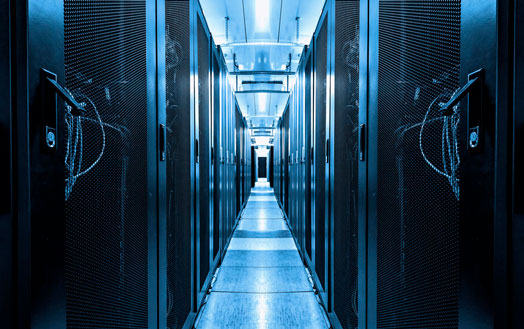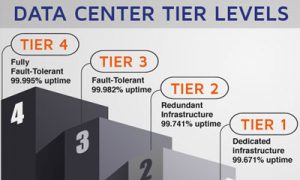Data Center Tiers

Data Center Tiers
Data Center tiers are an efficient way to describe the infrastructure components being utilized at a business’s data center. Although a Tier 4 data center is more complex than a Tier 1 data center, this does not necessarily mean it is best-suited for an organization’s needs. While investing in Tier 1 infrastructure might leave a business open to risk, Tier 4 infrastructure might be an over-investment.
Tier 4 Data Center: A Tier 4 data center is built to be completely fault tolerant and has redundancy for every component. It has an expected uptime of 99.995% (26.3 minutes of downtime annually).
Tier 3 Data Center: A Tier 3 data center has multiple paths for power and cooling and systems in place to update and maintain it without taking it offline. It has an expected uptime of 99.982% (1.6 hours of downtime annually).
Tier 2 Data Center: A Tier 2 data center has a single path for power and cooling and some redundant and backup components. It has an expected uptime of 99.741% (22 hours of downtime annually).
Tier 1 Data Center: A Tier 1 data center has a single path for power and cooling and few, if any, redundant and backup components. It has an expected uptime of 99.671% (28.8 hours of downtime annually).

Tier 4 Data Center Requirements
- Zero single points of failure – Redundancies for every process and data protection stream. No single outage or error can shut down the system.
- 995 % uptime per annum
- 2N+1 infrastructure (two times the amount required for operation plus a backup) – Fully redundant
- No more than 26.3 minutes of downtime per annum – Some downtime is allowed for optimized mechanical operations; however, this annual downtime does not affect user operations.
- 96-hour independent power outage protection – This power must not be connected to any outside source and is entirely proprietary. Some centers may have more.
Tier 4 is considered an enterprise-level service. Tier 4 has approximately twice the site infrastructure of a Tier 3 location.
If you need to host mission-critical servers, this is the level to use. Tier 4 data centers ensure the safety of your business regardless of any mechanical failures. You will have backup systems for cooling, power, data storage, and network links. Data Center Security is compartmentalized with biometric access controls. Full fault tolerance keeps any problems from ever slowing down your business. This is true even if you host less critical servers in other tier levels.
This tier also ensures optimized efficiency. Your servers are housed in the most physically advantageous locations. This drastically extends the life of your hardware. If the temperature and humidity are kept consistent, you gain a great deal of efficiency. Even the backups and dual power sources are treated like primaries.
.
Tier 3 Data Center Requirements
- 982 % uptime per annum
- N+1 fault tolerance (two times the amount required for operation plus a backup) – Ability to undergo routine maintenance without a hiccup in operations. Unplanned maintenance and emergencies may cause problems that affect the system. Problems may potentially affect user-facing operations
- No more than 1.6 Hours of downtime per annum – Downtime is allowed for maintenance and overwhelming emergency issues.
- 72 hours independent power outage protection – at least three days of exclusive power. This power cannot connect to any outside source.
Tier 3 provides most of the features of a Tier 4 infrastructure without some of the elite protections. For instance, the data center has the advantage of dual power sources and redundant cooling and the network streams are fully backed up. Guaranteed uptime is slightly less than Tier 4, and the system is not entirely fault-tolerant.
Tier 2 Data Center Requirements
- 741 % uptime per annum
- No more than 22 Hours of downtime per annum – There is a considerable jump between levels 2 and 3 regarding downtime. Redundancy is one of the primary reasons for this.
- Partial cooling and multiple power redundancies – A Tier 2 Data center will not have redundancy in all areas of operation. The most critical aspects of its mechanical structure receive priority. These two aspects are power and cooling distribution. Redundancy in these areas is only partial. No part of the system is fault tolerant.
The utility of a Tier 2 Data center is fundamentally different. If your business prioritizes redundant capacity components, then you may want to look at this level of infrastructure.
Tier 1 Data Center Requirements
- 671 % uptime per annum
- No more than 28.8 Hours of downtime per annum – There is a considerable jump between levels 2 and 3 regarding downtime. Redundancy is one of the primary reasons for this.
- Zero redundancies – A Tier 1 Data center will not have redundancy in any part of its operations. Facilities do not have any redundancy guarantees within its power and cooling certification process.
The use of the Tier I infrastructure designed for companies with a need for a colocation data center. This is the most budget conscious option for a business. The infrastructure consists of a single uplink, a single path for power, and non-redundant servers.
The tier classification system is another way of assessing redundancy and uptime reliability as you determine your organizations’ data center needs. Contact Zunesis to talk about your data center needs.
Categories
Search
Blog Categories
Related Resources
Archives
- April 2024
- March 2024
- January 2024
- October 2023
- September 2023
- August 2023
- July 2023
- June 2023
- May 2023
- April 2023
- March 2023
- February 2023
- January 2023
- October 2022
- July 2022
- June 2022
- May 2022
- April 2022
- March 2022
- February 2022
- January 2022
- December 2021
- November 2021
- October 2021
- September 2021
- August 2021
- July 2021
- June 2021
- May 2021
- April 2021
- March 2021
- February 2021
- January 2021
- December 2020
- November 2020
- October 2020
- September 2020
- August 2020
- July 2020
- June 2020
- May 2020
- April 2020
- March 2020
- February 2020
- January 2020
- December 2019
- November 2019
- October 2019
- September 2019
- August 2019
- July 2019
- June 2019
- May 2019
- April 2019
- March 2019
- February 2019
- January 2019
- December 2018
- November 2018
- October 2018
- September 2018
- August 2018
- July 2018
- June 2018
- May 2018
- April 2018
- March 2018
- February 2018
- January 2018
- December 2017
- November 2017
- October 2017
- September 2017
- August 2017
- July 2017
- June 2017
- May 2017
- April 2017
- March 2017
- February 2017
- January 2017
- December 2016
- November 2016
- October 2016
- September 2016
- August 2016
- July 2016
- June 2016
- May 2016
- March 2016
- February 2016
- January 2016
- December 2015
- October 2015
- September 2015
- August 2015
- July 2015
- June 2015
- May 2015
- April 2015
- March 2015
- February 2015
- January 2014
- February 2013




